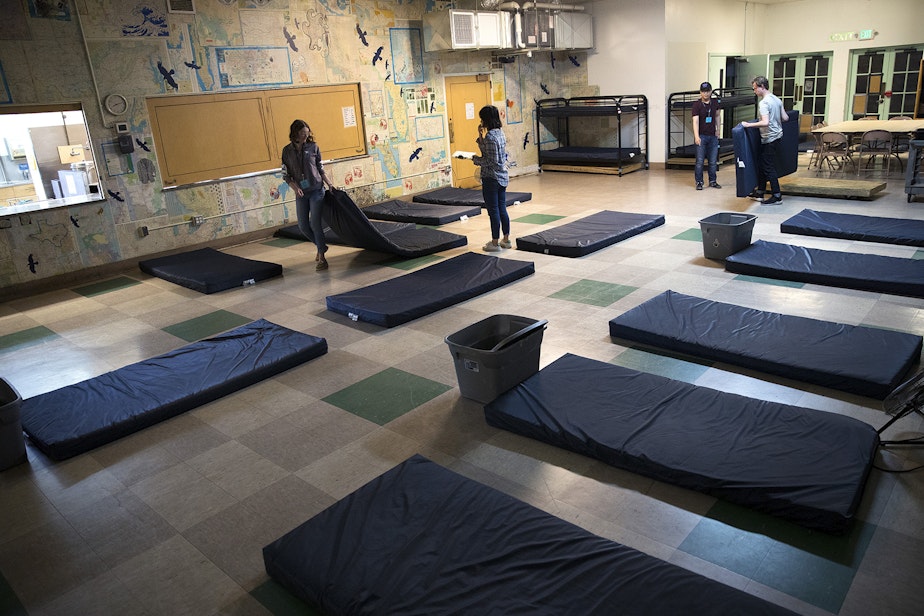Can we end youth homelessness? Seattle/King County sets goal for 2021

Seattle and King County leaders say they’re combining their efforts to end youth homelessness. They plan to achieve that goal by 2021.
Instead of working in silos, government, philanthropy and service providers will now work together on a coordinated campaign to tackle youth homelessness.
“We know that no one entity is going to be able to achieve alone what we can accomplish together,” said King County Executive Dow Constantine.
Young people who have experienced homelessness will also be heavily involved in the joint effort to help to craft solutions.
Local officials have failed in the past when they’ve announced plans to end homelessness. But this effort has some aspects not seen across the board in attempts to solve the crisis – including deep coordination and a focus on individualized solutions for the target population.
“We understand that all people have all sorts of different experiences and one model does not fit all,” said Leeze Castro, a member of the Youth Action Board, which is working on the effort.
Sponsored
Castro said including the voices of people like her, who have been homeless in their youth, will lead to more relevant solutions for those currently on the streets, in shelters and couch surfing.
The collaboration also brings significant resources to the table.
Along with money from a federal grant, this campaign to end youth homelessness will pool investments from Seattle, King County and philanthropic outfits — Pearl Jam's The Home Shows, Raikes Foundation, Schultz Family Foundation, and United Way of King County — to reach something known as "functional zero."
The effort won’t literally end all homelessness for young people. Instead, functional zero is achieved by trying to prevent young people from becoming homeless in the first place and, if they do become homeless, ensuring they’re housed within 30 days.
On a single night this January, more than 1,000 young people were counted as homeless in King County during the annual tally of people living in shelters and outside.
Sponsored
These are teens and young adults under 25 who are homeless on their own, not in families.
Although the annual tally is widely recognized as imperfect and merely a snapshot, the year over year results indicate some recent progress for homeless youth.
Between 2018 and 2019, the number of youth and young adults counted experiencing homelessness in King County fell by 28 percent. The number of children under 18 and without their family fell by 52 percent.
Still, officials acknowledge there’s far more work to be done.
Youth of color and LGBTQ youth continue to be vastly overrepresented in the homeless population.
Sponsored
More than a third of youth and young adults experiencing homelessness in King County identify as LGBTQ, 10 percent of homeless youth identify as American Indian or Alaska Native and roughly a third identify as black or African American.
Seattle Mayor Jenny Durkan said this reflects other failures in society.
“We need to recognize the systemic racism that has pervaded every system that we have,” she said.
Failing to prevent youth homelessness now may also contribute to more adult homelessness in the future.
Data from the 2019 one night count survey indicates nearly half of respondents had first experienced homelessness when they were under the age of 25.
Sponsored
"Ending youth homelessness really helps to reduce family homelessness and chronic adult homelessness, and so this is a really important investment for our community," said LaMont Green, lead youth and young adult homelessness planner for All Home King County, the group leading the new collaboration.
Over the next two years, people both locally and nationally will watch eagerly to see if the joint effort can achieve its goal of reaching functional zero.
Katy Miller with the U.S. Interagency Council on Homelessness said this level of collaboration between government, philanthropy, service providers and people who have been homeless is exciting.
“We’re not seeing that everywhere at this point. So Seattle/King County is really offering that leadership and model,” Miller said.
Miller said the approach is being watched closely at the federal level and she hopes to see the model duplicated elsewhere if it is successful.
Sponsored
Locally, lessons from this initiative may be applied more broadly once the new regional body to govern homelessness is established.
The city and the county are currently working to better coordinate their efforts across the whole homelessness service system.




